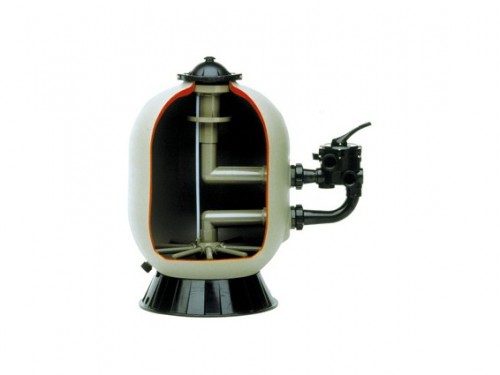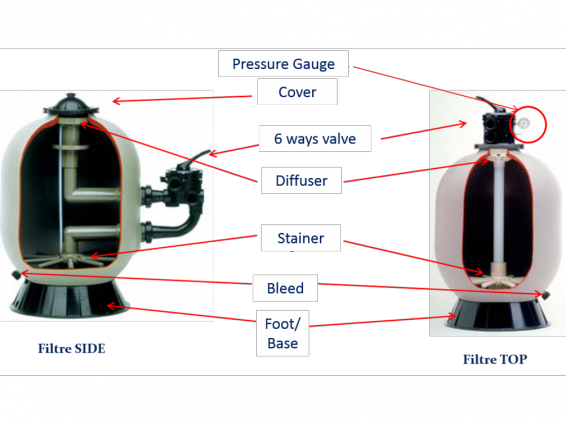
Filter: How to choose
Category : Construct
Essential component to ensure the quality of the water before the chemical treatment.
Let's Discuss Filters
The pool filter is installed after the pump on the filtration circuit.
Its flow rate is calculated according to the volume of the pool and adapted to the pump.
The filter flow rate must be higher than that of the pump to avoid operating under pressure (poor filtration, wear, risk of leakage). It should be chosen after the pump.
There are several types of filters:
Sand pool filter
- Most common on the market
- Easy to use, high flow rates possible - affordable price
- Filtration rating: approx 30 μ
There are filters called "Side" filters and "Top" filters used according to the available space.
Operation
The filter is filled with 1/3 of gravel, which protects the suction strainers, and 2/3 of sand, which ensures the filtration
- The water enters through the valve into the filter
- It is diffused to the top of the filter
- It passes through the sand, which will filter it
- Then it is recovered by the suction strainers
Such as for the pumps, there are different filter sizes to manage the different flow rates
Pump + filter assembly
Choose the pump: example for a pool of 10 x 5 (75m3): 15 m3/h
Then the filter, ideally with a greater flow rate.
Filter load
Sand + Gravel
- 1/3 gravel – 2/3 sand
- The most economic
Zeofine (zeolithe)
- 1/3 gravel, the rest is Zeolithe
- Advantages: filtration rating of 5µ
- Less chemical products, no need for an anti-algae product, buffering effect on pH
- Less pressure drops (less dense) therefore a less powerful pump is needed, same service life, but it will be used as fertilizer etc.
- Zeofine Gel retains dust when it is put into operation the first time
- Warning: no anti-algae, no other flocculant agent, no PHMB (Baquacil)
Glass
Cartridge filter: rating of 10 t 20 µ
- Limited floor space
- Cartridges are fastidious to clean in the event of green water
- Cartridges are to be replaced on a regular basis (2 to 3 years)
Diatomaceous filter: 3 to 5 µ (microns)
Uses a sedimented shell: the diatom becomes stuck to a polyester or nylon membrane stretched over a support system. The system is identical in principle to the sand filter.
Filtration rating: 5 microns
It contains a synthetic membrane whose role is to retain the diatoms (''skeleton'' of micro algae). Diatoms agglomerate on the membrane and form a filter layer. The impurities are removed from the water when it passes through the filter layer.
Advantages of diatoms - diatomite
- Filtration rating and reduces the consumption level of chemical product
- Compact filter
- Low water consumption due to a reduced cleaning frequency compared to a sand filter
Disadvantages of diatoms - diatomite
- Costly to purchase and for the pool operation: diatoms must be replaced on a regular basis
- Incompatible with flocculant products and excessively hard water


![Filtration-side-coupe[1] Filtration-side-coupe[1]](/images/medias/2983/_thumb3/Filtration-side-coupe[1].jpg)